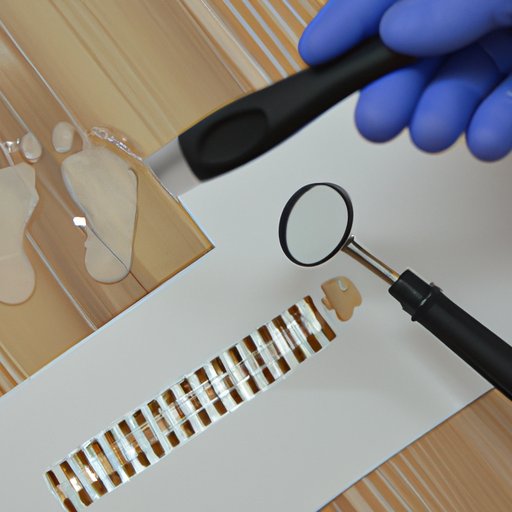Introduction
Forensic science is defined as “the application of scientific knowledge and methodology to legal problems and criminal investigations” (National Institute of Justice). It has become an invaluable tool in the practice of criminal justice, providing investigators with the means to solve cases that would otherwise remain unsolved. But when did forensic science start? In this article, we explore the history and development of forensic science, from its early roots in ancient China, India, and Europe to its modern-day applications.

Analyzing the History of Forensic Science: Tracing its Origins
The use of scientific methods to solve legal problems and criminal investigations can be traced back to ancient China, India, and Europe. In China, for example, a book entitled “The Washing Away of Wrongs” was published in 1248 by Song Ci, a magistrate who used his observations to develop theories related to crime scenes. Similarly, in India, the Arthashastra, written around 300 BCE, described ways of using physical evidence to investigate a crime. In Europe, during the Middle Ages, Italian physician Paolo Zacchia was one of the first to apply scientific principles to legal proceedings.

From Fingerprints to DNA Analysis: A Look at the Evolution of Forensic Science
Since then, forensic science has evolved significantly. One of the most important developments in the field of forensic science has been the emergence of fingerprinting as an identification tool. The idea of using fingerprints as a form of identification was first proposed by Englishman Henry Faulds in 1880. He suggested that fingerprints could be used to distinguish between individuals and suggested that they could be used to identify criminals. Since then, fingerprinting has become an invaluable tool for law enforcement officials.
In recent decades, DNA analysis has also become an indispensable part of forensic science. The rise of DNA analysis has revolutionized criminal investigations, allowing investigators to analyze biological samples such as blood or saliva to determine an individual’s identity. This technology has enabled investigators to solve crimes that would have otherwise remained unsolved.

Exploring the Roots of Forensic Science: Uncovering its Beginnings
The development of modern forensic science can be attributed to several key figures who laid the groundwork for its advancement. One such figure is Edmond Locard, a French criminologist who is considered to be the father of forensic science. Locard developed the concept of “exchange of evidence”, which states that when two objects come into contact, a trace of material is exchanged between them. This concept provided the basis for many of the forensic techniques used today.
Other important figures in the development of forensic science include Alphonse Bertillon, a French police officer who developed the technique of anthropometry, which uses physical measurements to identify individuals; and Hans Gross, an Austrian criminologist who developed the field of criminalistics, which applies scientific methods to the investigation of crime.
How the Development of Forensic Science Changed the Practice of Criminal Justice
As forensic science has advanced, so too has the practice of criminal justice. New technologies have allowed investigators to conduct more thorough and accurate investigations, while the increasing reliance on forensic evidence in courts has led to more convictions. According to a study conducted by the National Institute of Justice, “the use of forensic science in criminal justice has grown exponentially over the past two decades, resulting in more convictions and improved public safety.”
Examining the First Forensic Science Investigations: A Timeline
As we have seen, the history of forensic science dates back centuries. Here is a timeline of some of the most significant milestones in the development of forensic science:
- 1880 – Henry Faulds proposes the use of fingerprints as a form of identification
- 1890 – Alphonse Bertillon develops the technique of anthropometry
- 1900 – Hans Gross develops the field of criminalistics
- 1910 – Edmond Locard develops the concept of “exchange of evidence”
- 1970 – DNA analysis is developed
Some of the earliest cases solved using forensic science include the Jack the Ripper murders in London in 1888, the murder of Mary Phagan in Atlanta in 1913, and the Lindbergh baby kidnapping case in 1932.

The Emergence of Forensic Science: Key Milestones and Discoveries
In recent years, the field of forensic science has continued to evolve. Professional organizations, such as the American Academy of Forensic Sciences and the International Association for Identification, have emerged to promote the advancement of forensic science. Notable advancements in the field of forensic science include the development of new technologies such as facial recognition software, DNA phenotyping, and 3D imaging.
Using Forensic Science to Solve Crimes: A Closer Look at its Early Applications
Forensic science has been used to solve countless crimes throughout history. Some famous cases that have been solved using forensic science include the O.J. Simpson trial in 1995, the JonBenet Ramsey murder in 1996, and the 2001 anthrax attack. In each of these cases, forensic science played a critical role in helping investigators uncover the truth and bring the perpetrators to justice.
Conclusion
The history of forensic science dates back centuries, and its development has had a profound impact on the practice of criminal justice. From fingerprinting to DNA analysis, new technologies have enabled investigators to conduct more thorough and accurate investigations. Moreover, the increasing reliance on forensic evidence in courts has led to more convictions. As the field of forensic science continues to evolve, it will undoubtedly continue to play an essential role in solving crimes.
(Note: Is this article not meeting your expectations? Do you have knowledge or insights to share? Unlock new opportunities and expand your reach by joining our authors team. Click Registration to join us and share your expertise with our readers.)
